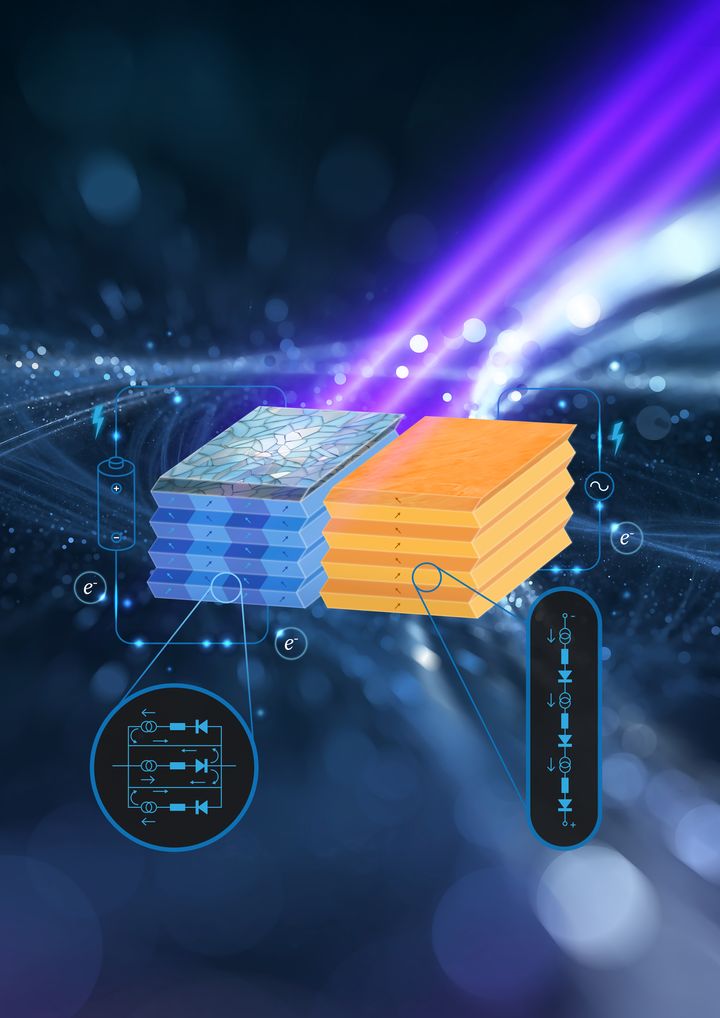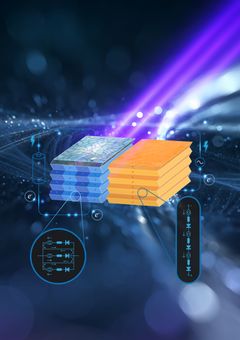Breakthrough in multifunctional solar cells
A recent article published by the research team led by Associate Professor Yang Bai from University of Oulu is highlighted as the back cover on the journal of Advanced Electronic Materials.

A team of researchers, including Vasilii Balanov, Jani Peräntie, Jaakko Palosaari, Suhas Yadav, and Yang Bai, has made an advancement in the field of multifunctional energy harvesting. Their latest study advances in understanding the photovoltaic effect in ferroelectric crystals. The article reports the team’s recent research results regarding improving the electric output of the bulk photovoltaic effect (BPVE) via manipulation of ferroelectric domains in oxide perovskite crystals. The title of the article is Study on Influence of AC Poling on Bulk Photovoltaic Effectin Pb(Mg1/3 Nb 2/3 )O3 -PbTiO3 Single Crystals
It is a bit difficult for non-specialists and requires explanation.
“In ordinary solar cells, the mechanism of harvesting the solar energy and then converting them into green electricity is based on the formation of p-n junctions of semiconductors. While the p-n junction has been invented for more than a century, widely used in the silicon industry nowadays, the BPVE is a more recently discovered physical phenomenon from the 1960s-1970s. The BPVE does not rely on p-n junctions to work under solar energy. It forms its own ‘‘self-junction’’ and, theoretically, it may break the physical limit of the Shockley-Queisser limit that prevents single p-n junction-based solar cells from being more efficient”, clarifies associate professor Yang Bai from Microelectronics research unit.
Using BPVE in practice is challenging at the moment, as the output power of BPVE-based cells is still negligible compared to those of p-n junction-based photovoltaic cells. In this study, Bai’s team proves that by creating a stacked domain structure, a 35 % improvement on the output power of BPVE-based cells can be achieved. A domain is a submicron-sized region containing spontaneous polarizations orienting in the same direction, which can be switched by applying an external electric field.
The improvement of electric output from Bai’s BPVE device is achieved by applying an AC poling electric field, under which the microstructure (domains) inside the crystals will be better aligned compared to the situation under the conventionally used DC field. After removing the electric field, the domains stay at that better aligned state. The better aligned domains help to reduce recombination of electric charge carriers, and thus the energy conversion efficiency increases. The results of the work pave a way towards developing more efficient BPVE cells that can help to unlock multifunctionality in future photonic, computing, sensing and energy harvesting devices.
“The first concrete applications will be in small-scale sensing and computing devices, where in addition to the electric signals, we can input light of different wavelengths as an extra degree of freedom for operation. For example, we have previously proven the use of BPVE in filterless colour sensor. Other examples include components for neuromorphic computing and multi-source energy harvesters for IoT (internet of things) devices”, says Yang Bai.
Despite the breakthrough now achieved, there is still a lot of research work ahead. Yang is aware of the challenges and the future goals are clear.
“While we are advancing in the working mechanism inside the materials, the challenge still lies in the band gap of the materials, where we ideally need a material that simultaneously has a narrow band gap (to maximise visible light absorption) and a large spontaneous polarization (to maximize the open-circuit voltage). We have limited options for such materials. Most available materials nowadays only possess either a narrow band gap or a large spontaneous polarization, not both. In the near future, we will attempt to expand the material options”, muses associate professor Yang Bai on behalf of his whole group.
This study has been published with the support of The European Research Council. ERC Starting Grant awarded to assistant professor Yang Bai for the project UNIFY in 2022.
The journal of Advanced Electronic Materials.
More information about the research project in the news article Yang Bai received significant ERC funding.
Avainsanat
Yhteyshenkilöt
Ville WittenbergCommunications Specialist
Science communications: information technology and 6G Flagship programme
Kuvat
Tilaa tiedotteet sähköpostiisi
Haluatko tietää asioista ensimmäisten joukossa? Kun tilaat tiedotteemme, saat ne sähköpostiisi välittömästi julkaisuhetkellä. Tilauksen voit halutessasi perua milloin tahansa.
Lue lisää julkaisijalta University of Oulu
Academy Professor Guoying Zhao awarded valued IAPR 2024 Maria Petrou prize11.12.2024 09:07:49 EET | Tiedote
The 2024 Maria Petrou Prize recipient is Guoying Zhao, University of Oulu Finland. She was recently awarded for her contributions to video analysis for facial micro-behavior recognition and remote bio-signal reading (RPPG) for heart rate analysis and face anti-spoofing.
98 nya doktorander rekryteras till Uleåborgs universitet26.3.2024 10:24:03 EET | Tiedote
Uleåborgs universitet in norra Finland rekryterar sammanlagt 98 doktorander för en period på tre år som en del av det nya pilotprojektet för doktorandutbildning som finansieras av det finska undervisnings- och kulturministeriet. Forskarna förväntas slutföra sin doktorsavhandling inom tre år. De första doktoranderna kommer att rekryteras under våren.
Solar Energy Harvesting Through Biomimicking the Wings of a Butterfly26.6.2020 15:45:00 EEST | Tiedote
Very effective nanostructures biomimicked from black scales of butterflies can be used for antireflective coating on solar panels. A new study of the NANOMO Research Unit of the University of Oulu offers a unique route to enhance light harvesting efficiency occurring in manmade solar cells.
Oulun yliopiston 11. tohtoripromootio siirtyy syyskuulle 202020.3.2020 09:54:24 EET | Tiedote
Oulun yliopiston vuoden 2020 tohtoripromootio siirretään koronaviruksen (COVID-19) aiheuttaman tartuntatautipandemian vuoksi syyskuulle. Tohtoripromootio pidetään 11.–13.9.2020. Tapahtuma järjestetään nyt ensimmäistä kertaa syksyllä, sillä perinteisesti Oulun yliopiston kaikkien tiedekuntien yhteistä tohtoripromootiota vietetään toukokuun lopulla.
Uutishuoneessa voit lukea tiedotteitamme ja muuta julkaisemaamme materiaalia. Löydät sieltä niin yhteyshenkilöidemme tiedot kuin vapaasti julkaistavissa olevia kuvia ja videoita. Uutishuoneessa voit nähdä myös sosiaalisen median sisältöjä. Kaikki tiedotepalvelussa julkaistu materiaali on vapaasti median käytettävissä.
Tutustu uutishuoneeseemme
